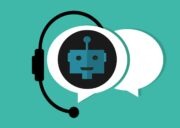
The use of chatbots is a fast-growing trend that meets the needs of all stakeholders. According to recent research, 80% of customer interactions can be resolved by well-designed bots (Accenture), 60% of consumers want easier access to self-serve solutions for customer service (Ovum), and 50% of enterprises will spend more on bots than on traditional app dev in 2021 (Gartner). This makes chatbots a great market for all developers.
If you are interested in fully understanding the potential of this area and the positives and negatives of the existing technology, don’t miss the opportunity to attend the Codemotion Online Tech Conference in October 2020!
If your interest turns more towards knowing more about how modern technologies and tools can support you in the organisation of – and during – a virtual event, don’t miss this article showcasing the best tools used as we have hosted our online conferences since the COVID-19 outbreak.
The conference will have many great speakers who will cover topics around designing UI and UX for chatbots, based on voice input. Check the website for more information: attendance is free!
Chatbots are becoming an increasingly powerful AI application, issued by every AI-based development framework. They make users happy, so they positively impact every aspect of business.
Because chatbots don’t require the user to understand the classification logic used when content is presented through a text-based user interface, they are being added in increasing numbers to classical websites, and showing very promising usage patterns.
Updated chatbots are becoming the new User Interface, often paired with the use of natural language and related technologies. It seems clear that some online activities will soon begin with a chatbot instead of a website.
Targeting the Internet of Things
Many cars now have a natural-language chatbot as the preferred interface with their software. That’s logical when your hands are busy and you can’t use tactile input devices.
We have already seen this in desktop computers and smartphone devices, and subsequently in separate hardware such as Smart Speakers and Smart Displays from many different suppliers.
All of these connect to one of three services: Alexa, Google Assistant, or Siri (Apple only). All of these devices, and many more, are part of the Internet of Things (IoT) – perhaps unsurprisingly, on its highest and most expensive level.
Lower levels exist and should be taken into account. There are many competing brands for home, office, building, and neighborhood automation. All of them use infrastructure to deploy Cloud/Edge/5G solutions based on AI services.
The current wave of AI services is becoming a commodity, so the competitive value needed to excel will demand new proprietary algorithms. Edge-server solutions will help most proximity services to deliver the best possible output in a specific geographic area.
The 5G paradigm, once correctly deployed, will reduce latency to match the human capacity to perceive reality, pushing the UI approach to something no tactile interface can match.
Voice-based approaches have existed since the 1950s, but they didn’t historically work that well. In more recent times, IoT has become a key element in this field. We now interact with so many devices, from coffee machines, washing machines, voice and home assistants to cars.
This paradigm switch needs to be considered when designing conversational approaches to customer care. New interfaces must also be fully integrated with the overall business software of a company and within the larger boundaries of the extended enterprise, including suppliers and, where possible, customers.
The number of IoT devices connected to an AI-based solution will rapidly increase – eventually they may challenge the AC plug for numerical supremacy.
This scenario is not as impossible as it may seem, because many off-grid IoT devices increasingly solve the power problem by drawing their operational current from photovoltaic cells or energy-harvesting techniques.
More skills are needed to maintain relevance in the current environment. Basic requirements include knowledge of Python, an understanding of AI and ML at a high level and of natural language processing. Serverless functions are also something to learn for those backend calls to a database or 3rd party API.
Forget the past: you need a new mindset
This is a brand new world to conquer and the appropriate tools are still under development. The main issue is following new mental pathways without falling back on past mindsets.
The normal approach has always followed a dead-end path. Flowcharts are disappointing when it comes to describing the conversation, so a quantum leap is needed. Many aspects need to be accounted for using AI and bots, and software code must be written a long time after the bot begins its analysis.
‘Artificial intelligence’ itself is a catchphrase that comprises many different components. Let’s look at some of the basic elements required to approach a solution. AI is still not that accessible as a whole and what’s needed here is something that doesn’t easily fit into a simple box.
The field of AI encompasses the Machine Learning (ML) zone that in turn incorporates the Deep Learning (DL) sphere: conversational AI can’t be confined to one of these areas, but asks for solutions that can be thought of as coming from all three zones (AI, ML, and DL).
Returning to bots, they classically try to handle too many things at once, and don’t often communicate with existing business systems. A proper bot solution is integrated with existing software in a multi-channel solution.
Any voice chatbot must implement Natural Language Understanding (NLU), today an easily-managed undertaking. AI and bot communication are technological problems that can be easily solved with correct analysis and a related business plan.
The largest part of the overall conversational user interface is thus outside technology. Finding the right approach to designing a solution is essential. Current use cases are not particularly strong: some bots lack transparency, they often don’t understand context, and they lack proper human escalation protocols.
API-based multi-channel AI solutions
How can we untie all these knots? A strategy is required.
What is needed to develop a solution? At least three elements must be clear: intent, entities, and context.
- Intent, in AI slang, is the capacity to identify the important verb in a sentence. The way people ask questions has to be understood; the same thing can be asked in thousands of different ways.
- Entities include many grammar units such as names, time, word roots, synonyms, and many more. For example, “Appointment at 3 PM tomorrow” is a sentence from which three variables need to be extracted and sent to the backend.
- Context can never be forgotten. We humans understand each other based on a range of assumptions that provide context. Reaching a sufficient level in this process takes time and requires life-long retraining of the AI model.
Once your basic AI model is trained, a multi-channel approach is needed to achieve success. The AI bot should work on more than one channel: web, car, tv, home… and it must connect all of these to the backend via robust APIs. The backend connection is crucial: without it, all the work done is wasted.
Talking to the user
Never forget that a conversational interface is based on well-written conversations that starts with a great script in a human language. A world-class conversational interface is a multi-step process that can be scheduled in seven steps:
- identify top user journeys that could be automated;
- create a business plan;
- design a persona;
- write professional scripts;
- connect to backend enterprise systems;
- build a proof of concept and collect feedback;
- connect to human agent systems for human intervention.
This approach is most effective in some key areas. Today’s most-advertised uses of this technology are at home and in the car, with IoT-based home assistants.
While the traditional area of business was B2C customer service, there is also a lot of space around enterprises with B2E organisational knowledge, onboarding, and helpdesk functions.
Want to launch a developer event despite the challenges of COVID-19?
If you want to know more about how modern technologies and tools can support you in the organisation of – and during – a virtual event, don’t miss this article showcasing the best tools used to host our online conferences since the COVID-19 outbreak.




